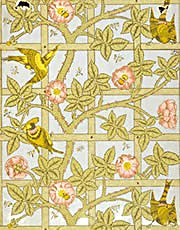William Morris (1834-1896) was a poet, artist, designer, Romantic, socialist, and a peddler of poisonous wallpaper according to researchers writing in the Science in Culture section of the journal Nature recently.
Morris was an advocate of a return to traditional craft styles and materials and is famed for helping found the so-called Arts & Crafts movement. His chintz patterns and elaborate wallpaper designs such as Daisy and Trellis, many of which were modelled on fifteenth century wall hangings, became favourites among the wealthier Victorians and remain to this day popular within a niche market. However, the well to do Victorians who decorated their parlours with Morris’ chintzy wallpapers could have been slowly poisoned by the fumes given off by his gaudy colours, especially if their chambers were damp. According to Andy Meharg of the University of Aberdeen, who has analysed a small sample of Trellis wallpaper loaned to him by the William Morris Gallery. The green pigment used in this early patterned wallpaper was found to contain the toxic element arsenic.

William Morris, peddler of poisonous paper? (William Morris aged 41, photographed by Frederick Hollyer (source: William Morris Gallery))
Meharg says that arsenic green is a synthetic compound of copper and arsenic, and is either Scheele’s green, discovered in 1775 and named for Swedish chemist Carl Wilhelm Scheele, or emerald green, which was first manufactured by a German company in 1814. The researchers says that thick areas of pigment could easily be scuffed forming a cloud of toxic dust, while fungi associated with damp conditions could convert the arsenic into a volatile form.
Morris was a shareholder and sometime director of a southwest mining company, Devon Great Consols (DGC), which was at the time the largest producer of arsenic in the world. Morris was well aware that many of his workers were beset with terrible arsenic-related illnesses, working conditions were atrocious. Indeed, The London Times had reported in the 1860s that children sleeping in bedrooms papered with materials containing arsenic green and other toxic pigments commonly died, overwhelmed by the fumes. And, according to legend, Napoleon Bonaparte died of arsenic poisoning because his rooms on St Helena exile were decorated with green-painted wallpaper.

Toxic wallhanging Daisy
Morris, however, chose to dismiss the contemporary health concerns over the pigment arsenic green and ignored the massive environmental damage his mines caused. Meharg points out that the impact of DGC’s operations persists to this day. Ironically, Morris has, explains Nature consultant editor Philip Ball, become something of an icon in the environmental movement. Indeed, the UK’s National Trust is set to re-open what is considered the pinnacle of Morris’ design achievements, his ‘Red House’ in Bexleyheath in London, where he commissioned and lived during the 1850s and 1860s.

Toxic wallhanging Trellis
At this time, however, the likes of William Henry Perkin were finding ways to make colourful synthetic compounds such as mauveine, the first industrial organic fine chemical. In his textile printmaking, Morris is reputed to have stubbornly rejected these new synthetic dyes, favouring instead traditional dyes based on plant and animal extracts, and as it turns out toxic minerals. The producers of his wallpapers, Jeffreys and Co, however, sufficiently worried about the toxic effects of arsenic green that they opted for a new pigment that did not contain the element in 1875.
Morris may have been a product of the age having as Meharg says double standards with respect to industry and pollution. Moreover, he later became a positive force in the fledgling environmental movement. Nevertheless, he demonized contemporary industrial practices as dehumanizing but remained silent as a stone on the devil in arsenic. As Morris enthusiasts and historians prepare to celebrate the re-opening of Morris’ Red House, one can only hope that they’ve since redecorated without the greens!
Further reading
Meharg, A. The arsenic green. Nature, 423, 688, (2003)
http://dx.doi.org/10.1038/423688a
DOI: 10.1038/423688a
William Morris
http://www1.walthamforest.gov.uk/wmg/home.htm
Arsenic
http://www.webelements.com/arsenic/
Philip Ball
http://www.philipball.com/
Mauveine
http://www.ch.ic.ac.uk/motm/perkin.html
Morris enthusiasts
http://www.morrissociety.org/
Suggested searches
Arsenic